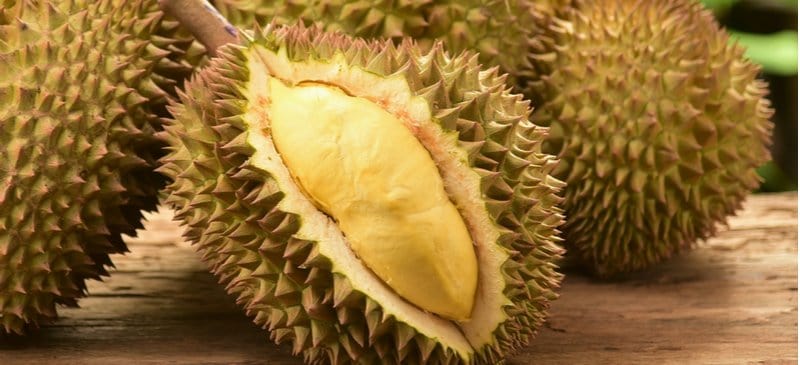This Dr. Axe content is medically reviewed or fact checked to ensure factually accurate information.
With strict editorial sourcing guidelines, we only link to academic research institutions, reputable media sites and, when research is available, medically peer-reviewed studies. Note that the numbers in parentheses (1, 2, etc.) are clickable links to these studies.
The information in our articles is NOT intended to replace a one-on-one relationship with a qualified health care professional and is not intended as medical advice.
This article is based on scientific evidence, written by experts and fact checked by our trained editorial staff. Note that the numbers in parentheses (1, 2, etc.) are clickable links to medically peer-reviewed studies.
Our team includes licensed nutritionists and dietitians, certified health education specialists, as well as certified strength and conditioning specialists, personal trainers and corrective exercise specialists. Our team aims to be not only thorough with its research, but also objective and unbiased.
The information in our articles is NOT intended to replace a one-on-one relationship with a qualified health care professional and is not intended as medical advice.
Durian Fruit: Smelly but Nutrient-Dense Superfood
June 13, 2025

Durian fruit has been utilized in Eastern medicine practices for many years, which isn’t surprising considering it’s rich in a number of antioxidants, anti-inflammatory compounds, vitamins and minerals. While this fruit hasn’t been studied as extensively as many others, it’s considered to be a valuable addition to one’s diet.
By including this superfood in your diet, whether by eating it raw, consuming its juices or supplementing with it in other ways, you can benefit from enhanced protection against certain nutrient deficiencies, metabolic-related issues, certain infections and more.
What is durian fruit?
Durian (Durio zibethinus L.) is an exotic tropical fruit that’s harvested primarily in Southeast Asian countries, including Thailand, Malaysia, Indonesia and the Philippines. It can be eaten both raw or cooked and has a strong, signature smell.
Durian fruits are greenish-brown in color, usually pretty large (although not as big as jackfruits) and have a spiky exterior. The durian fruit is sometimes also called “king of fruits.”
Inside the prickly shell is a white, yellow or red flesh. The flesh has a soft, custard-like texture that’s unlike most other fruits.
In addition to being edible, it’s also considered a potential therapeutic agent due to its valuable nutritional composition and presence of bioactive compounds.
Nutrition facts
Durian is considered by experts to be a very nutrient-dense fruit, particularly high in vitamin C, B vitamins (including thiamine, vitamin B6 and riboflavin), manganese and potassium. Unusually, it’s a fruit that contains fat. As a result, it’s higher in calories than most fruits, similar to avocado.
Durian fruit also contains some protein, another unusual feature of a fruit. Overall it’s a very balanced food, providing fiber, fat, protein and carbs all in one package.
Additionally, it supplies you with a range of protective compounds, including antioxidants, such as anthocyanins, carotenoids, polyphenols and bioflavonoids (the same types found in superfoods like berries, cocoa, red wine and green tea). Volatile sulfur compounds, esters and antimicrobials have also been identified in durian fruit.
A one-cup serving of raw or frozen durian (approximately 243 grams) contains about:
- Calories: 357
- Total Carbohydrates: 65.9 g
- Fiber: 9.2 g
- Total Fat: 13 g
- Protein: 3.6 g
- Cholesterol: 0 mg
- Sodium: 4.9 mg (0.2% DV*)
- Vitamin C: 48 mg (80% DV*)
- Thiamine: 0.9 mg (61% DV*)
- Manganese: 0.8 mg (39% DV*)
- Vitamin B6: 0.8 mg (38% DV*)
- Potassium: 1,060 mg (30% DV*)
- Riboflavin: 0.5 mg (29% DV*)
- Copper: 0.5 mg (25% DV*)
- Folate: 88 mcg (22% DV*)
- Magnesium: 73 mg (18% DV*)
- Niacin: 3 mg (13% DV*)
- Phosphorus: 95 mg (9% DV*)
- Pantothenic acid: 0.6 mg (6% DV*)
- Iron: 1 mg (6% DV*)
- Zinc: 0.7 mg (5% DV*)
*Daily Value: Percentages are based on a diet of 2,000 calories a day.
Durian vs. jackfruit, what’s the difference? Jackfruit is a similarly large tropical fruit that is high in many of the same nutrients, such as vitamin C and other antioxidants/phytonutrients, including lignans, isoflavones and saponins.
It’s lower in calories and fat than durian fruit and doesn’t have the same strong odor. It tastes more like banana/mango and is used in both sweet and savory recipes, including as a meat substitute due to its texture.
Health benefits
1. High in antioxidants, sulfur compounds and vitamin C
Because it contains high levels of antioxidants and essential vitamins like vitamin C, durian may neutralize cancer-promoting free radicals and defend against oxidative stress and inflammation.
Something else that makes this fruit unique is it contains sulfur-containing compounds, such as thioacetals, thioesters and thiolanes, as well as trace amounts of alcohol. These are the same types of compounds found in garlic, which have the ability to protect tissues and support metabolic pathways.
Studies have shown that durian fruit has anti-proliferative and even probiotic effects. It seems to be capable of aiding in the prevention of cancer cells spreading, promoting cardiovascular health by decreasing cholesterol and hardening of the arteries, and supporting cognitive/brain health.
It can also help support the skin, eyes and brain by reducing free radical damage.
2. Great source of B vitamins and folate
According to one study, durian fruit is a rich natural source of absorbable folate and B vitamins. These nutrients are important for metabolic health, maintaining nerve and muscle function, and supporting higher energy levels.
Folate in particular plays an essential role in metabolic pathways involving biosynthesis and remethylation of homocysteine to methionine. It helps prevent not only neural tube defects in newborns, but also increased levels of homocysteine that are associated with development of cardiovascular diseases and Alzheimer‘s disease.
The high amount of thiamine present in durian is also beneficial for glucose metabolism and maintaining health of connective tissues.
3. Can promote metabolic and reproductive health
Although more research on the topic is warranted, one traditional use of durian is as a fertility-enhancing agent.
Durian has been found to exhibit positive effects against various components of metabolic syndrome and polycystic ovarian syndrome (PCOS). This is due to its anti-inflammatory, antioxidant, anti-obesity, anticholesterol and antihypoglycaemic properties.
It’s also an ideal fruit for those who are sensitive to the effects of consuming sugar and carbs, since it has a lower glycemic index score due to its protein, fiber and fat content.
4. Helps support the immune system
Certain studies have uncovered evidence that durian leaf and roots contain febrifuge and anti-malarial properties, as well as many other nutrients that can support the immune system in fighting off viruses and infections.
Research is ongoing regarding its unique microbial composition and how it may be used for production of novel proteins and/or enzymes in the future.
Here are other potential benefits of durian fruit, though more research conducted on humans is needed to verify them:
- 5. May help manage blood sugar levels
- 6. Might lower cancer risk
- 7. May protect the heart
- 8. Might combat infections
- 9. May support digestion
- 10. Might aid blood pressure levels
- 11. May support weight maintenance
- 12. Might strengthen bones and joints
- 13. May help with anemia
- 14. Might promote sleep
- 15. May work as a natural aphrodisiac
- 16. Might provide anti-depressant properties
- 17. May enhance collagen synthesis due to its vitamin C content
- 18. Might improve skin pigmentation
- 19. May promote hair growth
How to use
Outside of Asia, the best places to find durian fruit are at Asian markets. You may be able to find it either fresh or frozen. One downside to purchasing it is that it’s one of the most expensive fruits produced in this region.
Look for fruits with light-colored spikes that don’t have dark brown or white patches. Try picking up and shaking the fruit, noticing if there’s any rattling sound. If there is, it indicates that it’s dried out and no longer good.
What does durian taste like, and what should you do with it? You can eat both the flesh and the seeds if they are cooked. The outside rind/skin shouldn’t be eaten, however.
People describe the taste of durian in different ways, for example, as a cross between flavors including garlic, cheese and almonds.
Here’s how you can use durian fruit:
- Not only can you eat the flesh of the fruit raw, but you can also cook with it, especially when it’s a bit overripe.
- It’s sometimes used to make candies, baked goods, sweet drinks and desserts.
- You can also use it in savory dishes, just like you would jackfruit, such in sauces and curries.
- Additionally, the juice is sometimes used just like other fruit juices are.
How to eat
Here’s how to eat durian (and how to crack open the fruit and get the ripe flesh out):
- First make sure that the fruit is ripe. This makes it easier to crack with a knife. One downside to eating ripe durian is that the smell is stronger, so some people choose to eat it a slightly under-ripe instead. Use ripe durians immediately before they start to spoil.
- To cut into the fruit, place the durian stem side down and cut through the thick skin on the top of the fruit. Pull the skin back.
- Lay the two halves down, and then remove the “pods” of fruit plus the inside flesh along the shell. Next remove the large, inedible seeds before eating or cooking.
- To help reduce the smell of durian, you can run hot water through the durian skin, which helps remove some of the particles that contribute to the aroma.
Once you’ve gotten the smooth flesh out, try durian in recipes such as healthy cakes, shakes and savory dishes like stir-fries. While most people prefer it in sweetened recipes, which can help mask the taste, it mixes well with spices, rice and veggies, too.
Use the fresh fruit right away or within a couple of days of it starting to ripen. Keeping it in the refrigerator is a good way to keep it fresh for longer.
You can store the cooked fruit in the refrigerator for several days when kept in a tight container.
Why is durian fruit so stinky?
What does durian smell like? The smell depends on the specific type of durian, plus how ripe it is. It’s more likely to be very smelly when it’s ripe.
The strong odor of the fruit is thought to be attributed to the presence of sulfur compounds (like those found in onions and garlic) and other enzymes. While these are not usually bad for you to consume, they may leave you feeling nauseated if the smell bothers you a lot.
One study found that the fruit contained at least 44 different odor-active compounds, including those that are responsible for the smell of cabbage, soup seasoning, eggs, caramel and roasted garlic. Research has shown that these include sulfurs and “odorants,” such as ethanethiol, 1-(ethylsulfanyl)ethane-1-thiol, methanethiol and ethane-1,1-dithiol.
Risks and side effects
Why might durian be bad for your health? While it’s generally a very healthy food, it can interact with other substances, such as alcohol, and potentially cause side effects.
Side effects of consuming durian may include nausea, vomiting and heart palpitations if eaten with alcohol.
Is the durian fruit banned anywhere? Due to its off-putting smell, it’s been banned in some countries from being brought into certain public places, hotels and on mass transit.
Frequently asked questions
What does durian taste like?
Durian fruit has a rich, custard-like texture with a complex taste that combines sweet and savory flavors. People often describe it as a mix of almonds, caramel, vanilla, garlic and onion.
Some compare the flavor to sweet cheese or egg custard. Taste varies by variety and ripeness, and while many love it, others find it overpowering.
What does durian smell like?
Durian fruit has a famously pungent smell. It’s often described as a mix of rotten onions, turpentine, sewage or gym socks.
The smell is so strong and lingering that it’s banned in many hotels and public places across Southeast Asia. However, some durian enthusiasts find the aroma appealing once they get used to it.
Why is durian banned in the U.S.?
Durian isn’t actually banned across the U.S. It’s legally imported and sold in specialty Asian markets, usually frozen.
However, it’s often banned in certain public spaces or transport systems in some countries (not the U.S.) due to its strong odor. That said, fresh durian fruit is rare in the U.S. due to strict import regulations and the fruit’s short shelf life.
Why do I feel sick after eating durian?
Some people feel nauseous, bloated or overheated after eating durian. This may be due to:
- Its richness: High fat and carbohydrate content can overwhelm sensitive stomachs.
- Natural compounds: Durian fruit contains sulfur and alcohol-like compounds that may trigger mild reactions.
- Combining with alcohol: Consuming durian with alcohol can cause nausea or indigestion because it may impair alcohol breakdown in the liver.
Why is durian fruit so expensive?
Durian is expensive because of:
- Labor-intensive harvesting and short season
- Large size and weight
- Transportation costs, especially for air-freighted fresh durians
- Export regulations
- High demand and low supply in non-tropical countries
Premium varieties like Musang King or Monthong can be especially pricey.
Is durian fruit a superfood?
Yes, durian fruit can be considered a superfood due to its nutrient density. It’s rich in:
- Vitamin C, potassium, B vitamins (especially B6) and fiber
- Antioxidants that may help fight inflammation
- Healthy fats and natural sugars for sustained energy
However, it’s also high in calories and should be eaten in moderation.
Can I eat durian fruit daily?
You can eat durian daily in small amounts if you are healthy and not sensitive to it. However:
- It’s high in calories and carbs, so portion control is key, especially for those watching blood sugar or weight.
- If you feel bloated, overheated or nauseous after eating it, you may want to cut back or consult a healthcare provider.
- People with kidney issues or on potassium-restricted diets should also be cautious.
Conclusion
- Durian is a nutrient-dense fruit that has a strong smell and unusual taste. It’s high in calories for a fruit, due to its content of healthy fats.
- This fruit is a great source of vitamin C, B vitamins, fiber, manganese and more.
- It can be eaten raw or cooked and added to both sweet and savory recipes.
- Benefits of consuming durian fruit include supporting the immune system, metabolic health, cognitive functions, digestion and skin health, along with reducing free radical damage and more.

